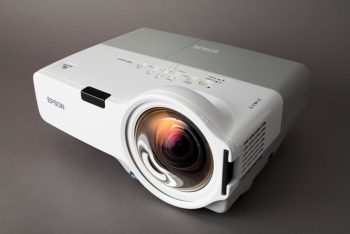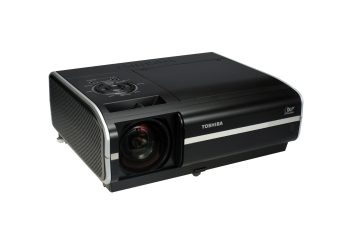You no longer need a flush, corporate-sanctioned budget in order to afford a portable business projector. Today, you can find a good projector for as little as $500, with more powerful and full-featured models hovering in the $1,000 to $1,500 range. When you consider that an entry-level model cost $1,500 a couple of years ago, you can see why it’s worth taking a look.
“The projector industry is changing rapidly, and the market is growing,” says Mike Isgrig, Director of Epson Projection for Epson America Inc., one of the industry heavyweights. “The pricing has come down quite a bit, so projectors are a lot more affordable for a small-business entrepreneur.”
This lets more first-time buyers into the game, and it also allows larger organizations to equip more employees, rather than having a limited loaner pool. “As prices come down over time, the projector will become a personal device, not a shared one,” predicts Isgrig.
Projectors also aren’t just about displaying static slides and pie charts anymore: Web sites and video are now the norm, thanks to software tools like PowerPoint 2007 and Apple’s Keynote, which make it easier to create media-rich presentations. “You can express your ideas in a much more persuasive manner,” says Isgrig. “When people see images rather than text, studies show their recall goes way up.”
So for any business owner that needs to sell — be it a product or an idea — a projector is an essential tool. Here are the features and specs to consider when weighing your purchase.
 |
| The Epson PowerLite 400W offers WXGA resolution and short-throw technology. |
Brightness
Brightness, or the amount of light a projector can produce, is arguably the most important spec to look at when comparing projector models. The more light an engine puts out, the more likely you are to be able to present a decent image even in a room that isn’t completely dark.
Fortunately, major projector makers adopted one industry standard for reporting the amount of light a projector delivers to the screen, measured in lumens. You’ll see the spec quoted as ANSI lumens (for the American National Standard Institute); while the rating doesn’t indicate how good an image will be, it does at least put all units on a level playing field when it comes to measured light output.
As a rule, a unit with a rating of 1,000 to 1,500 ANSI lumens is acceptable for use in an office or small conference room where you can control the light coming from windows and overhead sources. But if you typically present in a larger conference room, or in a room where you can’t dim the lights and close the shades, you’ll want a unit in the 2,000 to 3,000 ANSI lumen range.
Brightness uniformity is another important specification, as it indicates how consistent the image brightness is when measured in the center and at the corners. Ideally, a projector will have a brightness uniformity rating of 90 percent or better; a low figure is a warning that the center portion of the image will be noticeably brighter than the edges. Of course, manufacturers are not required to divulge this spec, so if a unit has poor uniformity, you won’t see that rating listed in the specs.
Size and Weight
As with a notebook PC, another decision is what size machine you need. Ultra-portable projectors (that is, models weighing between 2.5 and 4 pounds) are the right choice for a road warrior who needs a presentation device with her as a near-constant companion. As with a notebook PC, miniaturization costs: An ultra-portable model will typically run a few hundred dollars more than a larger unit with similar (or better) specs. But if the device and its accoutrement will be slung over your shoulder as you schlep through airports, every pound counts.
If you use the projector mainly in your office or a meeting room, with only an occasional road trip, consider a projector in the 4.5- to 7-pound range. You’ll generally get a brighter image and more features for your dollar.
Resolution
As with any display device, the sharpness and clarity of the picture depends largely on the number of pixels that comprise it. Portable projectors predominantly come in two native resolutions: SVGA (800-by-600 pixels) and XGA (1,024-by-768 pixels). The more pixels, the more detailed the image.
Many people will be well served by an SVGA projector. The typical PowerPoint presentation and even video will look fine, and you can find a good model for as little as $500. However, if your agenda includes displaying Web sites and text-heavy applications (such as Excel spreadsheets or Word docs) opt for a higher-resolution model. You will be able to display more of a given document or Web page without scrolling, and smaller text will be noticeably easier to read.
As with laptop screens, projectors now come in wide-screen 16:9 formats. These WXGA (1280-by-800) projectors are more expensive than XGA models, but might be preferable if you present video content created in 16:9 format — or if you plan on using the unit as a home-theater companion after hours (we won’t tell the IRS if you won’t). But for the vast majority of buyers, the traditional 4:3 aspect ratio is the way to go.
Short-throw Technology
One annoyance with data projectors is their placement in relation to the screen in order to create a large image. Typically, a unit has to sit on a table six to eight feet from the screen to project an image suitable for a conference-table full of viewers. So you have a power cord running from the wall to the device (a tripping hazard in a darkened room), and you need to be mindful not to walk in front of the light beam while also trying to be in front of your audience.
But in the past few years new optics technologies have solved this problem. These “short-throw” projectors can be placed three feet or so from the screen and still generate an 80-inch image. This lets you place them on a console or cart close to the wall, with less worry about cable clutter or people walking between the projector and the screen. Available from Epson, NEC, Toshiba and others, short-throw projectors carry a price premium versus long-throw units, but the positioning flexibility they provide could make them attractive choices.
Connectivity
The connectivity options a projector comes equipped with should also be on your radar. They can make the difference between breezing into a room and getting started effortlessly, or fumbling with cables and settings in front of your audience and wasting their valuable time.
 |
| Toshiba’s TDP-EX20U features 2,300 ANSI lumens, and it delivers 60-inch image when placed a mere three feet from the screen. |
The most common way to connect a laptop PC to a projector is via a VGA cable; almost every laptop has a VGA-out port, and every projector has a VGA input. Many projectors now support USB connectivity, letting you use a thin USB cable rather than a bulky VGA cable. And an even newer choice is an HDMI connector, which caries both the audio and video over a single thin cable. HDMI out ports are now appearing on high-end laptops, and on multimedia-centric projectors, as well.
Many conference-room projectors now also support wireless connections, letting you send the presentation data to the device via Wi-Fi. This is ideal at times when several colleagues need to connect during the course of the meeting, as it avoids the painful laptop-and-cable shuffle as presenters switch off.
Of course, the easiest way to connect is not to have to bother at all. If you don’t need to present “live” material, look for a projector that can play back your canned presentation from a USB memory device or a memory card. This lets you pop in the memory device and present, no cables or PC required.
Other Considerations
As you narrow your choices, there are other features to consider. One of our favorites is an “instant-off” feature. With a typical projector, the bulb needs a few minutes to cool down before you can unplug the unit and pack it up. This can be awkward at the end of a meeting, as your hosts check their watches while you wait for the projector to cool down. With an instant-off projector, there is no cool-down period required; turn it off and you’re ready to go.
Color fidelity is another consideration. With a PowerPoint slide, it may not matter if sun yellow gets reproduced as mustard yellow. But for video and photographic images, where natural flesh tones and other color attributes are important, a projector’s color accuracy becomes more important.
Another thing to keep in mind is the noise of the projector fan. The bulbs produce a lot of heat, so efficient cooling is important. But a less than ideal design will result in fan noise that may be distracting to your audience. And speaking of bulbs, look for a unit with a long rated life for the bulb, as replacements typically cost a couple hundred dollars. Some manufacturers now offer 4,000-hour bulbs, which should equal years of use before you need to replace it.
Finally, consider the service and support the various manufacturers provide. If you depend on your projector for make-or-break deals, look for a warranty that offers a next-business-day replacement unit: You ship a broken projector back (under warranty), while they send a replacement unit to you. And 24/7 live tech support is also helpful, since you’ll usually discover any problems on the Sunday night before that big Monday morning pitch.
This article was first published on Small Business Computing.
-
Huawei’s AI Update: Things Are Moving Faster Than We Think
FEATURE | By Rob Enderle,
December 04, 2020
-
Keeping Machine Learning Algorithms Honest in the ‘Ethics-First’ Era
ARTIFICIAL INTELLIGENCE | By Guest Author,
November 18, 2020
-
Key Trends in Chatbots and RPA
FEATURE | By Guest Author,
November 10, 2020
-
Top 10 AIOps Companies
FEATURE | By Samuel Greengard,
November 05, 2020
-
What is Text Analysis?
ARTIFICIAL INTELLIGENCE | By Guest Author,
November 02, 2020
-
How Intel’s Work With Autonomous Cars Could Redefine General Purpose AI
ARTIFICIAL INTELLIGENCE | By Rob Enderle,
October 29, 2020
-
Dell Technologies World: Weaving Together Human And Machine Interaction For AI And Robotics
ARTIFICIAL INTELLIGENCE | By Rob Enderle,
October 23, 2020
-
The Super Moderator, or How IBM Project Debater Could Save Social Media
FEATURE | By Rob Enderle,
October 16, 2020
-
Top 10 Chatbot Platforms
FEATURE | By Cynthia Harvey,
October 07, 2020
-
Finding a Career Path in AI
ARTIFICIAL INTELLIGENCE | By Guest Author,
October 05, 2020
-
CIOs Discuss the Promise of AI and Data Science
FEATURE | By Guest Author,
September 25, 2020
-
Microsoft Is Building An AI Product That Could Predict The Future
FEATURE | By Rob Enderle,
September 25, 2020
-
Top 10 Machine Learning Companies 2020
FEATURE | By Cynthia Harvey,
September 22, 2020
-
NVIDIA and ARM: Massively Changing The AI Landscape
ARTIFICIAL INTELLIGENCE | By Rob Enderle,
September 18, 2020
-
Continuous Intelligence: Expert Discussion [Video and Podcast]
ARTIFICIAL INTELLIGENCE | By James Maguire,
September 14, 2020
-
Artificial Intelligence: Governance and Ethics [Video]
ARTIFICIAL INTELLIGENCE | By James Maguire,
September 13, 2020
-
IBM Watson At The US Open: Showcasing The Power Of A Mature Enterprise-Class AI
FEATURE | By Rob Enderle,
September 11, 2020
-
Artificial Intelligence: Perception vs. Reality
FEATURE | By James Maguire,
September 09, 2020
-
Anticipating The Coming Wave Of AI Enhanced PCs
FEATURE | By Rob Enderle,
September 05, 2020
-
The Critical Nature Of IBM’s NLP (Natural Language Processing) Effort
ARTIFICIAL INTELLIGENCE | By Rob Enderle,
August 14, 2020
SEE ALL
APPLICATIONS ARTICLES









